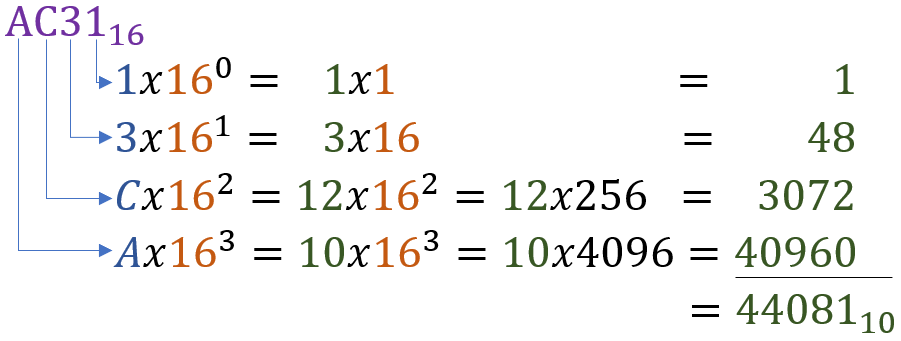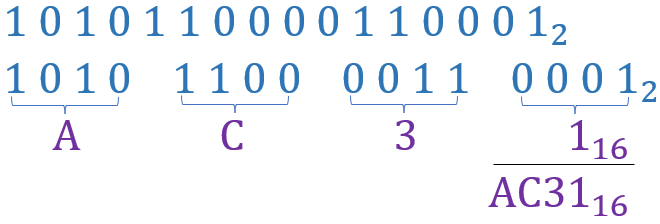Hexadecimal Values
Understand how base 16 (hex) number system is a shorthand to base 2 (binary)
Key Concepts |
|
Terms
| Term | Meaning |
|---|---|
| Binary | Base 2 numbers. |
| Decimal | Base 10 numbers. |
| Hex or Hexadecimal | Base 16 numbers. |
| Place or Place Value | Value of a single number in multi-symbol value. Example: In the number 12345, the Place Value if the 3 is 300. |
| Signed | Numbers that represent negative, zero, and positive values. |
| Symbols | Written characters used to depict numbers. Symbols represent to represent Decimal are 0,1,2,3,4,5,6,7,8,9. |
| Unsigned | Numbers that represent only zero and positive values. |
Introduction
What is Base 16?
Base 16 Number System
| Property | Value |
|---|---|
| # of symbols | 16 |
| Symbol Range | 0 - F |
| Symbols | 0 1 2 3 4 5 6 7 8 9 A B C D E F |
| Place Value Factor | 16 |
Base 16 (Hexadecimal or Hex) is a number system you will likely encounter in various places in Computer Science. While a bit odd looking at the start, Hex is a shortcut to describing binary values in a compact manner
Converting to Base 10
The algorithm used to convert from Binary to base 10 works here, just changing the base to 16. We also need to use the lookup table (above) to convert each Hex value to Decimal

Algorithm
Recall that number positions in a number string start at zero. So the value in the 1st position is said to be in position 0
Also, we will be raising 16 to the power of the position, because the original number is in Base 16
- Convert each Hex value to Base 10 using the lookup table
- Multiply the resulting Base 10 value by 16 raised to the power of the value's position
- Add the result to the final Decimal result
- Repeat for all Hex values
You'll Need a Calculator for this
Raising 16 to increasing powers is not easy to do in your head. And, in the above example, notice each Hex place value grows substantially. This is why Base 16 results in very compact numbers that represent large Decimal values
16^2
Converting to/from Binary

This is where Hex is that compact representation of binary
Each Hex value represent 1 4-bit Binary string. And a 4-bit Binary value can be represented by a single Hex value
| Binary | Decimal | Hex | Binary | Decimal | Hex | |
|---|---|---|---|---|---|---|
| 0000 | 0 | 0 | 1000 | 8 | 8 | |
| 0001 | 1 | 1 | 1001 | 9 | 9 | |
| 0010 | 2 | 2 | 1010 | 10 | A | |
| 0011 | 3 | 3 | 1011 | 11 | B | |
| 0100 | 4 | 4 | 1100 | 12 | C | |
| 0101 | 5 | 5 | 1101 | 13 | D | |
| 0110 | 6 | 6 | 1110 | 14 | E | |
| 0111 | 7 | 7 | 1111 | 15 | F |
Conclusion
Converting from Hexadecimal to Decimal is the same algorithm and Binary to Decimal, just using a different base number in the conversions.
Hexadecimal is useful in expressing binary values in a compact format. Each Hex symbol represents exactly four (4) binary numbers.
